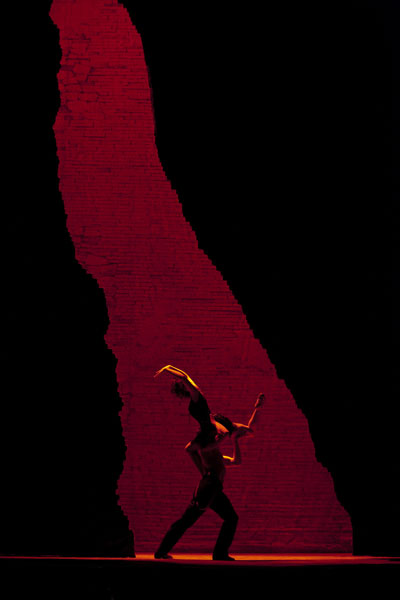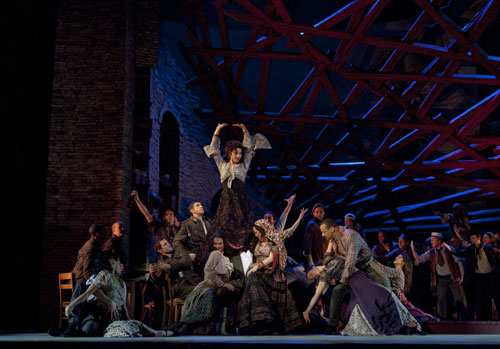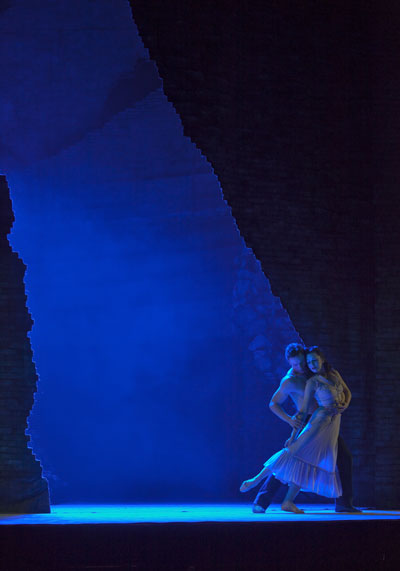
The portentous red gash in the curtain at the new Richard Eyre production of Carmen at the Met opens to reveal two dancers who become entwined. It is a brief moment of elegance and sensuality amidst a heavy Spanish Civil War era transposition of the piece, which Eyre suggests he used to "push the extremes between the world of the gypsies and the society...[the] more repressive sexual norms." After an opening which sets up Carmen as a sexually promiscuous firebrand, the dancers return after the interval--and in a brief moment set the stage for a scene which devolves around a dance and shows how tantalizing movement can be as part of a seduction.
When you're used to being the main course, it's hard to be the dessert. Yet Christopher Wheeldon manages to impart the sensuality that Eyre was looking for in fiercely balletic terms and buttresses the overall conception of desire as being a large part of our rasion d'etre in the intermittent moments when his choreography is given reign. And Maria Kowroski, a favorite New York City Ballet Dancer, gives Met audiences, perhaps not as a familiar with the company next door at Lincoln Center, a soupcon of her alluring style. Martin Harvey, her partner, has most recently starred in Dirty Dancing in London.
I had a chance for a short email chat as Wheeldon returned to the States after a break after this new production of Carmen debuted New Year's Eve.

Maria Kowroski and Martin Harvey as solo dancers during the overture to Act I of Bizet's "Carmen." Photo: Ken Howard/Metropolitan Opera Taken at the Metropolitan Opera during the dress rehearsal on December 23, 2009.
CZ: Though Carmen is an opera which has an unusual emphasis on dance, it's still eclipsed by the voices. How does it feel to have dance be in second position? Or have you made the entr'actes into something that could possibly stand alone?
CW: In the case of this opera, the dance serves the story. The story takes first place and is described by the music, voices and dance. Of course the singing is the primary communicator in opera, but as in a musical, the dance has to serve the story in some way. The entr'actes stand alone but are still representative of the action. The dancers represent both the fate of Carmen and Don Jose and the innocence of a moment of their love that we never see in the opera. In this case they tell a part of the story not told in the opera itself.
CZ: You have an affinity for opera, having danced with an opera ballet company as a young boy. Has this made you a more effective collaborator?
CW: I think my experience working with Nic Hytner on a musical contributed to my being a good collaborator with Richard. I was there to help him with his vision for the Opera. Working with a director is fascinating, especially one as plot and character driven as Richard.
A scene from Act II of Bizet's "Carmen" with Elina Garanca (center) in the title role. Photo: Ken Howard/Metropolitan Opera Taken at the Metropolitan Opera during the dress rehearsal on December 21, 2009.
CZ: How closely did you work with Richard Eyre?
CW: Richard knew exactly how the opera should move, he worked closely with me on the parts of the opera he felt he needed me on. I was for much of it, a fly on the wall soaking up his great skill as a theater director.
CZ: Morphoses is already a demanding gig, and you like working with dancers you've come to trust can interpret your vision. How did you manage to work rehearsals and working with a whole new set of dancers into your schedule?
CW: I work with many dancers outside of Morphoses. I enjoy the challenges that new personalities throw my way. Having said that, many of these dancers I had worked before. Just the flamenco dancers were new and they were hugely inspiring.
Maria Kowroski and Martin Harvey as solo dancers during the overture to Act III in Bizet's "Carmen." Photo: Ken Howard/Metropolitan Opera Taken at the Metropolitan Opera during the dress rehearsal on December 22, 2009.
CZ: I've seen your presentations in Vail. You are clearly someone who has the "big" picture in mind. Does it make you want to direct an opera in it's entirety?
CW: Maybe one day I'll direct, if it's the right opera and I feel that I truly understood how to pull the kind of raw and passionate performances that I think classic operas in our time need. A fresh perspective is integral to the survival of any art form. I say booo to those who are stuck in their old ways. Let the arts move on!
Carmen is being performed until May 1; dates available in the link.


